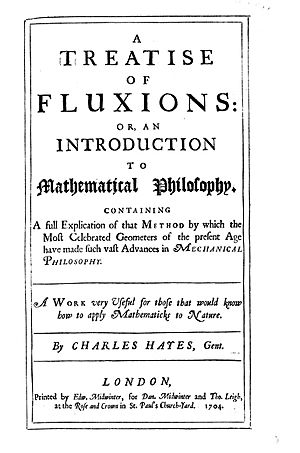Charles Hayes (mathematician) facts for kids
Charles Hayes (1678–1760) was an English mathematician and chronologist. He wrote an important early book about a math method called "fluxions." He was also an official and supporter of the Royal African Company. This company was one of the first British companies involved in the trade of enslaved people.
Life of Charles Hayes
Charles Hayes was a member of Gray's Inn, a famous legal society in London. He once traveled to Africa and spent some time there. Because of this trip, he became known as a skilled geographer. He was chosen each year to be a leader, either a sub-governor or deputy-governor, of the Royal African Company.
In 1752, the Royal African Company was closed down. After this, Hayes moved to Downe, Kent. People who knew him said that Hayes spent a lot of time doing science experiments. His calm personality and clear way of explaining things made him well-liked. Another scholar, Charles Hutton, noted that Hayes was very knowledgeable but also very humble. Charles Hayes passed away in his rooms at Gray's Inn on December 18, 1760.
Works and Writings
In 1704, Charles Hayes published his book, Treatise on Fluxions, or an Introduction to Mathematical Philosophy. This was the first English book to explain Isaac Newton's method of "infinitesimals," also known as fluxions. This method is a key part of calculus. In his book, Hayes showed how to use Newton's method to find tangents of curves, calculate areas, and solve problems about maximum and minimum values. His introduction showed he had read many math books.
In 1710, he printed a short book called New and Easy Method to find out the Longitude. This book explored ways to figure out a ship's position at sea. In 1723, he wrote The Moon, a Philosophical Dialogue. In this book, he suggested that the Moon might not be completely dark, but could have some light of its own.
After studying Hebrew, Hayes wrote more books about history and ancient texts. In 1736, he published Vindication of the History of the Septuagint. Then, in 1738, he wrote Critical Examination of the Holy Gospels according to St. Matthew and St. Luke. These books looked at the history of Christ's birth. From then on, his studies mostly focused on chronology, which is the study of arranging events in time. He also wrote some papers to support the Royal African Company.
In 1747, his book Series of Kings of Argos and of Emperors of China from Fohi to Jesus Christ came out. He wrote this to show that the dates and order of these ancient rulers matched the Septuagint, an ancient Greek version of the Hebrew Bible. In 1751, he published Dissertation on the Chronology of the Septuagint. This book defended the ancient timelines of Chaldea and Egypt.
Later in his life, Hayes started a big project called Chronographia Asiatica & Ægyptiaca. He did not finish this work before he died. Only two parts were published in his last two years. In these parts, he argued that the authors of the Septuagint and the historian Josephus used writings from the library of the Second Temple of Jerusalem. He believed these writings were not included in the Old Testament canon.


